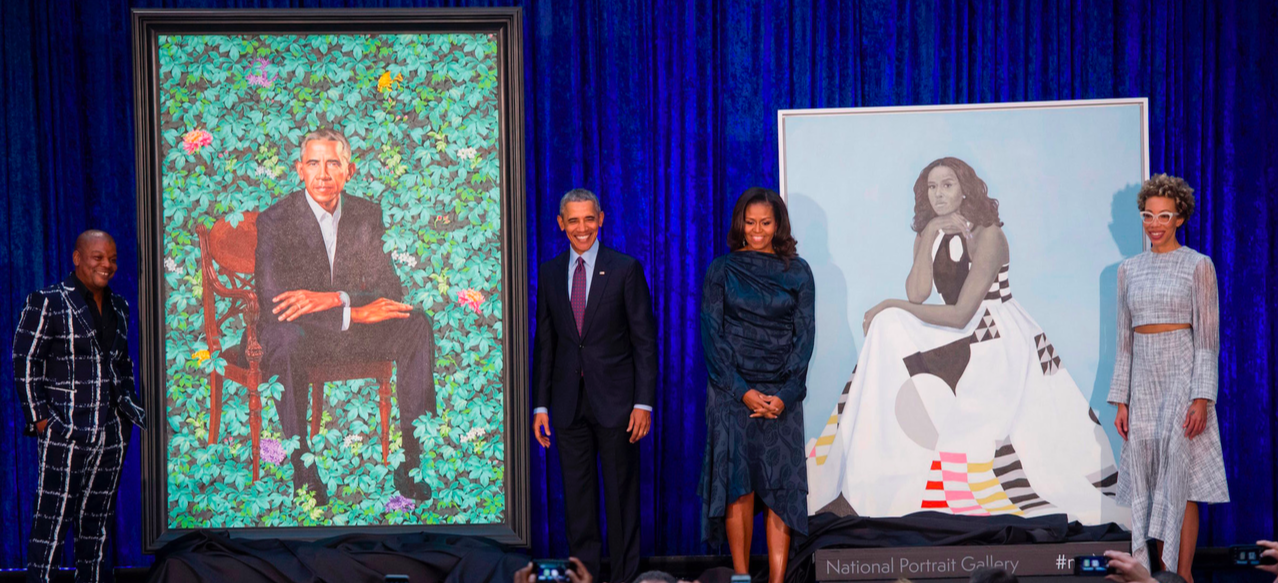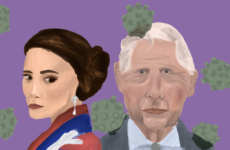
Former President Barack and First Lady Michelle Obama unveil their new portraits on February 12 at the National Portrait Gallery in Washington, D.C.
My first thought was: that’s not Michelle Obama. Certain differences struck me: her nose was too pointed, her nostrils were too large, her cheekbones were too low. Still, I found myself curious about the former First Lady’s new portrait in the National Portrait Gallery. When I discussed my opinion with a friend, she responded that the painting itself didn’t matter as much as the symbolism. I concur, because the painting really doesn’t resemble her.
Both of the Obamas’ recently unveiled official portraits are shockingly unique. In the 21st century, theirs are the first portraits commissioned by black painters. Kehinde Wiley, former President Obama’s portraitist, and Amy Sherald, Michelle Obama’s portraitist, were chosen out of a pool of artists because of their long histories of painting portraits of black individuals in an empowering and novel manner. Not too long ago, Sherald was a waitress struggling to support herself; the recent unveiling of the portraits has already catapulted her into the spotlight. She has also had to overcome many hurdles in order to get where she is today, including her own heart failure and her brother’s death from cancer. Wiley, on the other hand, has work hanging in the Museum of Modern Art in New York and has already achieved international notoriety.
Wiley and Sherald made interesting artistic choices when painting the Obamas. For example, Sherald chose to forgo painting Michelle brown; instead, Sherald’s signature gray was used to fill in Obama’s body. Sherald chose to do so to avoid “making a political statement” by painting brown skin: the grey, she thinks, removes the possibility of marginalization. It’s an interesting way to depict a presidency that was irrefutably affected and occasionally defined by race. The style of the painting was unique; especially when you compare Obama’s with the official portrait of her predecessor, Laura Bush. While powerful, Obama isn’t formal or stiff – her composure doesn’t convey restriction. Her posture evokes femininity and reminds the viewers of Auguste Rodin’s “The Thinker,” conveying the message powerful women can think for themselves. This message also fits Michelle Obama’s personality. She wasn’t a traditional First Lady; she wasn’t docile, she wasn’t silent, and she wasn’t afraid. Though Sherald’s portrait may not represent Obama’s face accurately, it’s fair to say that Sherald nearly perfectly depicted Obama’s character and individuality.
President Obama’s portrait, on the other hand, was more accurate. Upon first glance, one can identify the global powerhouse based on his facial features. He leans forward, juxtaposed against a wall of greenery. Underneath him is a wooden chair. His arms are crossed and his thin wedding band is visible. Unlike Michelle, Barack was painted brown; his portrait is decidedly more vibrant than his wife’s. Chrysanthemums poke out from between the leaves: they’re the official flower of Chicago, Obama’s hometown. Wiley, the painter, acknowledges that “there is a fight going on between he and the foreground and then the plants that are sort of trying to announce themselves underneath his feet.” He describes the relationship between the background and the foreground as being symbolic of the control of the narrative of Obama’s presidency saying that “it’s all chance-driven.”
While the Obama’s portraits differed greatly from each other in style, they shared a similar mission. Artists Amy Sherald and Kehinde Wiley both attempted to capture the Obama’s presidency and influence the way that the Obamas will be remembered for centuries to come. For now, it looks like they were successful, but it’s too soon for us to tell. If you’re ever in Washington, D.C., you can pop into Smithsonian Museum’s National Portrait Gallery–President Obama’s on the second floor, First Lady Michelle Obama’s on the first.




